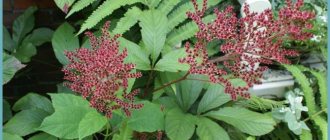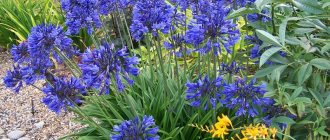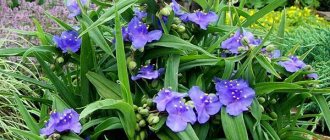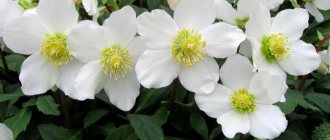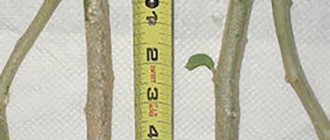Purslane is an annual plant of the Portulaceae family. Translated from Latin, its name means “collar”, which is associated with the peculiarities of opening the boxes. Also known as Dandur and "rugs". The latter was achieved due to the fact that many types of plants spread on the ground, forming beautiful grass carpets. Purslane grows in open ground in the North Caucasus, Altai, Asia and Belarus. The homeland of this annual is India. The range of uses of the plant is very wide; it is used for medical purposes, cosmetology, cooking and landscape design. Purslane looks great in group plantings and in combination with other plants. Growing and caring for them will require regular weeding, watering and thinning.
Dandur: varieties and photos
Purslane has about 200 varieties. Some of them have taken root well in our country. It has needle-shaped fleshy leaves; there are double and non-double types. The flowers resemble roses in appearance.
Purslane is the most common species in central Russia. It grows up to 30 cm in height. The leaves and stems are bright green and are used as food.
Purslane
Purslane grandiflora is a plant with succulent leaves. Flowers come in various colors: snow-white, red, orange, etc. Flowering, as a rule, begins in mid-June and continues until the cold weather. The species is considered decorative. Popular varieties are Double Mix, Cream, Cherry and Sunglo.
Purslane grandiflora
Terry purslane is an annual, decorative species that serves as a decoration for terraces and flower beds. The flowers have double caps of white, yellow, orange and red. For active growth and massive flowering, the plant needs bright light. Its varieties are white-flowered purslane and Splendence.
Terry purslane
- White-flowered purslane is a plant with incredibly beautiful double flowers;
- Purslane 'Splendence' is an unusual plant with bright purple flowers.
Interesting Facts
In addition to the main name - purslane (Portulaca, lat.), which means “collar”, some additional names have been assigned to the flower:
- chicken leg;
- rogue weed;
- midday heat;
- dandur;
- sandwich
Each of them reflects some characteristics of the plant, and each has its own story. In particular, Arabs in the Middle Ages found the plant “blessed,” and in the time of Hippocrates it was used as a medicine to help with toxic snake bites and insomnia. Whereas in certain countries where it grows, the plant is considered a weed.
In general, the genus Portulaca includes almost two hundred species of annual and perennial herbaceous plants. Almost one hundred of them belong to decorative plants. Nevertheless, in temperate latitudes, only two such species are cultivated - purslane flowers of decorative type and vegetable flowers. The latter is revered for its healing properties, and is also widely used in cosmetology and cooking.
Purslane: planting and care
It is best to grow purslane through seeds. In March, it is necessary to plant the seeds in special soil, it is taken from the garden plot, loosened and spilled with water.
Purslane seeds
Stages of planting:
- Sowing seeds in a pot. This is done with gentle pressing movements.
- The pot must be covered with film and wait for the first shoots. Purslane loves good lighting, so it should be placed in a sunny place.
- After emergence of shoots, the film must be removed. Purslane sprouts are very weak, you should not water them, but you can and should spray them.
- After one month, dandur seedlings are planted in separate containers, placed in a warm place and watered with settled water.
Purslane seedlings
You can plant seedlings in open ground when the weather settles and warm days arrive. It is preferable to do this in the morning or evening. The distance between plantings should be at least 15 cm. This will make caring for the annual plant easier and will give the opportunity to grow a beautiful carpet.
Attention! Frail sprouts may die when temperatures fluctuate.
Many argue that dandur is a completely unpretentious plant that does not require any care. This is not entirely true. Purslane requires regular watering; the plant should not be allowed to dry out. Watering should be done once every 5–7 days, more often in hot weather. Weeding from weeds is a must.
Attention! Purslane is undemanding to soil composition; even the most sparse areas are suitable for it. Blooms actively only in sunny places.
In general, growing annuals is not burdensome, but requires periodic interventions.
Description of culture
Some gardeners call purslane a weed, since it grows in depleted soil, where many crops do not take root, and grows very quickly if excess bushes are not removed. In addition, it does not need to be planted every year; after flowering, the seeds fall off, are perfectly preserved during the winter and germinate in the spring. In another way, the flower is called a “rug” due to the fact that it spreads along the ground, completely covering the soil.
The flower belongs to the Portulacaceae family. This is an annual crop, since it cannot survive the winter, even if it is protected from frost. The root is branched, the stem is brown, branched, the leaves are fleshy. The flowers have different diameters and colors, depending on the variety. Blooms from June to late September. The lifespan of one flower is 1 day, but due to their large number and the constant formation of new buds, flowering does not stop.
Garden purslane belongs to succulents - plants that store water in their stems and leaves. Its leaves are fleshy, the shape depends on the variety, most often oblong or spatulate. The flowers are yellowish, very small, collected in bunches. In place of faded seeds, a box with small seeds appears. The stems and leaves are eaten.
Important! The plant’s homeland is North and South America. The main method of propagation is self-seeding.
Purslane: reproduction
Plant propagation occurs through seeds; self-seeding is common. It can also propagate by dividing bushes and cuttings.
Purslane sprout
- Planting seeds. It is better to purchase seeds in stores at the end of winter or early spring. The seedlings are prepared in advance.
- Self-seeding It is produced by self-ejection of seeds from a ripe plant capsule. As a rule, this happens involuntarily. Thus, in a few years you can grow a real grass carpet on your own. The only thing is, if not properly cared for, it will go wild and become overgrown with weeds.
- Propagation by cuttings. This process occurs by rooting the shoot in sandy soil composition. Requires infrequent watering. The cuttings take root very quickly and can be kept in a pot until planted in open ground.
Recipes
If you have no contraindications to the use of purslane, then you can prepare it for future use and replenish your body with useful substances when the need arises...
To prepare dishes from purslane, at the market or in your garden, choose plants that are rich green in color, before flowering. Then the purslane should be washed well with warm water, dried and placed in the refrigerator for several days.
Recipe for making purslane in brine:
Prepare the brine: Place salt and pepper in boiling water, cook over low heat for 3 minutes, remove from heat, add vinegar. Cool.
For 1 l. water - 1 tbsp. l. salt, 10 black peppercorns, 2 tbsp. l. 9% vinegar.
Place the purslane in boiling water and cook over low heat for 5 minutes, if very young, then 3 minutes.
Then drain in a colander and put in a jar. You can add garlic cloves and chopped red pepper to taste.
Fill with cooled brine to the top, close with lids and place in the refrigerator or cellar.
After 3 days, the purslane is ready. Store in a cool place.
Recipe for fresh purslane salad:
Boil fresh purslane as in the first recipe, drain in a colander, squeeze and season:
Take 300 gr. spicy herbs - 20 grams apple or wine vinegar, 3 grams. garlic and pepper to taste.
Recipe for Lebanese Fattoush Salad for 4 people:
- Tomatoes - 250 gr.
- Bell pepper - 200 gr.
- Cucumbers - 250 gr.
- Red onion (Mars) - 150 gr.
- Garlic - 3 teeth.
- Lettuce leaves or chard (for decoration) - 50 gr.
- Parsley or cilantro - 20 gr.
- Purslane - 20 gr.
- Basil - 10 gr.
- Mint - 5 gr.
- Lavash - 1 pack.
For refueling:
- Olive oil - 4 tbsp. l.
- Lemon juice - 3 tbsp. l.
- Garlic - 3 teeth.
- Black pier pepper - to taste
- Salt - to taste
Preparation:
- Prepare the pita bread. Divide it into random pieces and fry in a heated frying pan with a small amount of vegetable oil.
- While the pita bread is cooling, let's start chopping the remaining ingredients. Rinse all vegetables and herbs.
- Cut the tomatoes, bell peppers at random, cucumbers and radishes into thin semicircles and place everything in a deep bowl.
- Chop the herbs: parsley, cilantro, basil, purslane and mint. Add chopped greens to vegetables.
- Chop the red onion into thin half rings and combine with vegetables and herbs.
- Now prepare the dressing. Grind the garlic in your usual way, add salt and pepper, add lemon juice and olive oil. Add dressing to the bowl with vegetables and mix our salad well.
- Place lettuce or chard leaves on a wide, slightly shallow dish. Transfer our salad from the bowl onto the leaves, and top with pieces of pita bread.
Our Fatush salad is ready!
Good health and bon appetit!
PS And for those who want to get rid of purslane in their garden, I can give advice: pull it out by the roots and take it away from the site and you will soon stop meeting this uninvited guest so often.
I hope you find this information useful!
Dandur: diseases and pests
Purslane is not particularly susceptible to disease. At times it can be affected by a fungus, and the leaves become spotted in appearance. In this case, the affected leaves should be removed and the plant treated with a fungicide containing copper.
Advice. If the dandur has been attacked by aphids, then a solution of laundry soap will help you in the fight against it.
Silvery spots on the plant indicate the appearance of thrips. Only insecticides can deal with them.
Purslane is eaten
Purslane: areas of application
Dandur is truly a versatile plant. Growing it as food is common in the Caucasus. The stems of the plant are used to prepare salads, soups, side dishes and additives for meat and spicy dishes. Characterized by a tart and spicy aftertaste. Those who have tried it say it tastes like a mixture of spinach and sorrel.
Purslane is used to treat many ailments. Stems infused with alcohol are suitable for the treatment of psoriasis, arthritis and ulcers, and the seeds are used as lotions for lichen. It also helps against insomnia, scurvy, flatulence, eye diseases, dysentery and diabetes. Due to its low calorie content, it can be used in dietary nutrition. This miracle plant is also capable of treating gynecological diseases and maintaining potency. The content of a large amount of vitamins and microelements helps fight seasonal vitamin deficiencies.
When used correctly, purslane can be used as a medicinal plant.
Fresh purslane juice is an excellent way to combat warts, helps with peptic ulcers and problems with the digestive organs.
Has a number of contraindications:
- Individual intolerance.
- Vegetovascular dystonia.
- History of seizures.
Combination with other plants and role in landscape design
Due to the fact that the plant takes root in poor soils, purslane is an ideal option for use in landscape design. They decorate garden plots and are used to design alpine slides.
Rockeries shrouded in dandur look neat and at the same time original. Suitable for propagation in mixborders, with purslane should be in the foreground.
Purslane is planted in flower beds, in flowerpots and on alpine hills
Terraces, balconies, verandas, gazebos and vases are decorated with purslane. The plant goes well in a composition with marigolds, zinnias and nasturtiums.
Purslane is an annual, ornamental, medicinal plant, used in cooking and everyday life. It can be grown on any soil, as it is practically unpretentious in caring for itself. As the plant grows, it forms a lawn that does not need to be mowed, and in the summer it will delight you with flowers of various colors.

